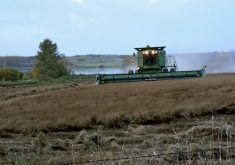Meat Processing
Landmark moment as pork passes beef
CHICAGO, Ill. (Reuters) — The U.S. government recently raised its pork production forecast for the year-to-date period ending September 2015 that shows pork surpassing beef for the first time since 1952, as hog farmers recover from a deadly pig virus.
In the monthly World Agriculture Supply and Demand Estimates (WASDE), the U.S. Department of Agriculture raised the commercial pork production forecast for 2015 to 23.9 billion pounds.
That is a 2.6 percent upward revision from last month’s data, a five percent production increase versus 2014 and for the first time exceeds beef output in 62 years.
Read Also

Canadian Grain Commission to use surplus to avoid fee increases
The Canadian Grain Commission will continue to use its surplus to cover budget shortfalls and avoid potential fee increases until 2028, the federal agency announced Monday, Oct. 27.
USDA projected 2015 beef output at 23.8 billion lb., with a marginal upward revision from the September report and a 2.3 percent decline versus last year’s production.
The sooner-than-expected improvement by pork producers from the Porcine Epidemic Diarrhea virus, which killed an estimated eight million pigs in the U.S. since May of 2013, will result in more hogs in 2015, said USDA and market analysts.
Markets
East Africa-EU deal renewed
NAIROBI, Kenya (Reuters) — Five east African nations have reached a deal with the European Union to renew a duty-free export regime for fresh fruit, vegetables and flowers they sell to the 28-nation bloc.
The deal, which is expected to take effect early next year, came after earlier negotiations failed to meet a Sept. 30 deadline, which means the five countries’ horticulture exports have been subject to EU customs duty since Oct. 1.
The Economic Partnership Agreements must still be ratified by the five members of the East African Community: Kenya, Tanzania, Uganda, Rwanda and Burundi — and by the European Parliament.
World Hunger
South Sudan faces famine
LONDON, U.K. (Thomson Reuters Foundation) — Famine could strike another million people across South Sudan early next year if the civil war escalates, a recent report states.
Aid agencies fear an imminent upsurge in fighting once the rainy season ends this month, which could wipe out recent efforts to avert famine and push areas of the world’s youngest country into starvation by March next year.
Some 10,000 people have died and 1.7 million, one seventh of the population, have been displaced since conflict broke out between president Salva Kiir’s government forces and rebels allied to his former deputy Riek Machar.
Tariq Riebl, head of Oxfam in South Sudan, said although humanitarian aid was vital, a political resolution was urgent.
“If the international community really wants to avert a famine then it has to make bold diplomatic efforts to bring both sides to end fighting,” Riebl said in a statement as the report was released.
Despite significant international aid and a recent lull in fighting due to the wet season, nearly 2.2 million people currently faced starvation, the report said.
Malnutrition was also a serious concern. In addition to limiting food production, the conflict has also disrupted markets and pushed up food prices, the report said.
South America
Weather casts doubt on coffee harvest
SAO PAULO, Brazil (Reuters) — Brazil’s National Coffee Council said the climate outlook is “unfavorable” for the country’s 2015 coffee crop, citing forecasts that see little chance of rain in the country’s main growing regions for the near future.
Coffee trees that have suffered from drought in 2014 could still yield a normal crop in 2015, the council said in a statement, but they would need rain in the next few days.
Such rain was unlikely before Oct. 23, according to weather forecasting firm Somar, whose outlook was cited by the council.
“We believe the drought should damage the next harvest but it is still too early to define the extent because that is completely dependent on the rains,” the council, which represents producers, said in a statement.
CNC president Silas Brasileiro has previously said the 2015 crop may dip below 40 million bags, which would make it the country’s smallest since 2009.
Statistics
USDA to restart U.S. oilseed crush
(Reuters) — The United States Department of Agriculture is taking over a series of industrial grain and oilseed reports discontinued in 2011 by the U.S. Census Bureau but USDA will not begin publishing data until 2015.
The reports include statistics for the dry and wet alcohol milling and flour milling sectors, as well as the cotton, fats and oilseeds industries. The reports, discontinued due to census budget cuts, were followed by traders and analysts to gauge monthly consumption of grains and oilseeds.
Among the reports to resume will be the soybean crush report, which provided key data on how many soybeans were processed into soyoil and soymeal each month. Trade sources had hoped the reports would resume in late 2014.
But Alex Minchenkov, a spokesman for the USDA’s National Agricultural Statistics Service, said “it’s not going to be this year.”
Data collection could begin next month, he said.














